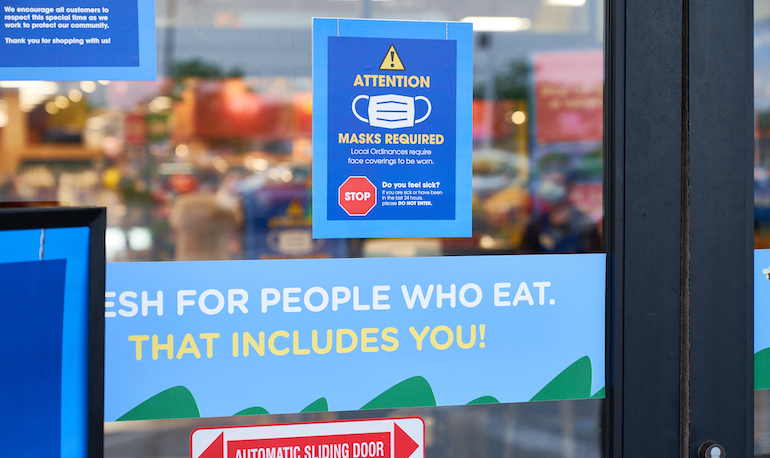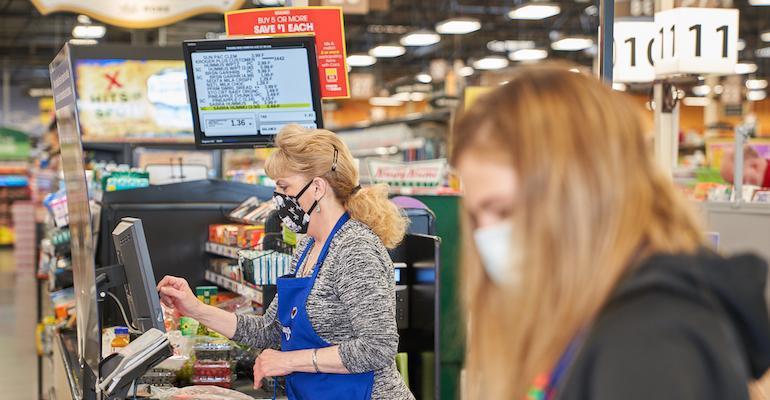Grocery sales climbed more than 8% in December and more than doubled that growth rate on a two-year stack, according to national retail sales tracker MasterCard SpendingPulse.
Year over year, grocery retail sales rose 8.3% for December, Purchase, N.Y.-based MasterCard reported yesterday. Since December 2019, the category has seen sales increase 16.9%.
The gain reflected robust overall retail sales growth for the month as shoppers stepped up their holiday purchases. Total retail sales gained 10.3% excluding automobiles and were up 6.9% backing out both autos and fuel, with the latter category still experiencing elevated per-gallon pricing.
By sector, restaurants tallied the strongest growth, with sales up 51.9% year over year in December, followed by luxury retailers (+46.8%), apparel stores (+46.3%), jewelry stores (+31%), department stores (+19.1%) and electronics/appliances retailers (+16%).
MasterCard SpendingPulse’s December data includes both in-store and online retail sales. The results come on the heels of a strong holiday sales period. From Nov. 1 to Dec. 24, total retail sales excluding autos increased 8.5% year over year, including 8.1% growth for in-store retail.
E-commerce continued its growth surge for both periods. Online sales jumped 13.5% in December and were up 60.4% since December 2019, MasterCard SpendingPulse said. And for the holiday selling season, digital sales advanced 11% versus the prior-year period and were up 61.4% over two years.
Looking at key trends, Mastercard expects this retail “e-volution” to persist as both retailers and consumers further embrace online channels.
“Retailers and brands spent much of the pandemic shifting or expanding their digital channels, which we see reflected in the SpendingPulse figures, as online sales continued to experience strong growth in December,” MasterCard stated. “In 2022, innovation will be amplified with retailers looking at different platforms and tactics to reach hyperconnected consumers.”
Retailers also are expected to take a more experiential approach to enhance omnichannel shopping.
“Innovation has been vital as retailers started to think of their digital and physical stores more cohesively than distinctly separate channels. This trend brought us ‘phygital’ innovation in how retailers engage with customers digitally and in person,” according to Mastercard. “We expect the ability to make purchases ‘how I want’ will continue, requiring retailers to offer hybrid models.”
NRF sheds light on Omicron effect
One near-term factor for the retail market is the impact of the surge of the Omicron variant of COVID-19. Though the fast-spreading variant will cloud the nation’s economic outlook for 2022 and could contribute to inflation, it’s unlikely to trigger widespread shutdowns or slowdowns, National Retail Federation (NRF) reported this week.

The fast-spreading Omicron COVID-19 variant is likely to cause consumers to focus spending on goods rather than services, according to the National Retail Federation.
“While Omicron is highly transmissible, its effects can be relatively mild for those who are fully vaccinated, and broad-based lockdowns are not expected,” NRF Chief Economist Jack Kleinhenz said in a statement. “Little is certain about Omicron’s impact on consumer demand, but people who stay at home because of the variant are more likely to spend their money on retail goods rather than services like dining out or in-person entertainment. That would put further pressure on inflation, since supply chains are already overloaded across the globe.”
Inflation started gradually and then came on strong during 2021 and stands to continue in 2022 but eventually subside, according to Kleinhenz.
“If there is one lesson we have learned, it is not to underestimate the resilience of the consumer and, therefore, the U.S. economy,” he added. “Fortunately, we have a lot of tailwind in terms of job growth, spending and production as we turn the calendar to 2022.”





